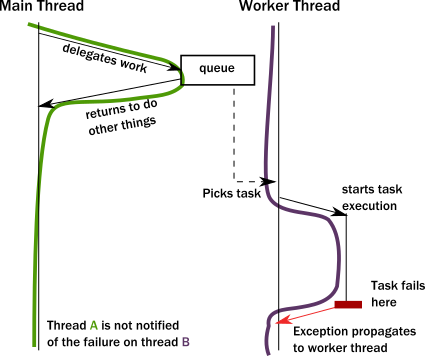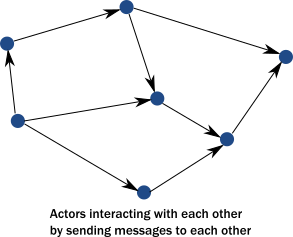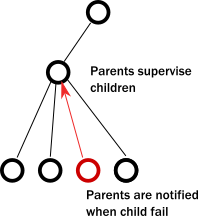Akka - Basis for Distributed Computing
Some concepts as blow:

- Welcome to Akka, a set of open-source libraries for designing scalable, resilient systems that span processor cores and networks. Akka allows you to focus on meeting business needs instead of writing low-level code to provide reliable behavior, fault tolerance, and high performance.
- Many common practices and accepted programming models do not address important challenges inherent in designing systems for modern computer architectures.
- To be successful, distributed systems must cope in an environment where components crash without responding, messages get lost without a trace on the wire, and network latency fluctuates.
- Multi-threaded behavior without the use of low-level concurrency constructs like atomics or locks — relieving you from even thinking about memory visibility issues.
- Transparent remote communication between systems and their components — relieving you from writing and maintaining difficult networking code.
- A clustered, high-availability architecture that is elastic, scales in or out, on demand — enabling you to deliver a truly reactive system
- Akka’s use of the actor model provides a level of abstraction that makes it easier to write correct concurrent, parallel and distributed systems.
- By learning Akka and how to use the actor model, you will gain access to a vast and deep set of tools that solve difficult distributed/parallel systems problems in a uniform programming model where everything fits together tightly and efficiently.
- Provides a way to handle parallel processing in a high performance network — an environment that was not available at the time.
- Objects can only guarantee encapsulation (protection of invariants) in the face of single-threaded access, multi-thread execution almost always leads to corrupted internal state. Every invariant can be violated by having two contending threads in the same code segment.
- While locks seem to be the natural remedy to uphold encapsulation with multiple threads, in practice they are inefficient and easily lead to deadlocks in any application of real-world scale.
- Locks work locally, attempts to make them distributed exist, but offer limited potential for scaling out.
- Additionally, locks only really work well locally. When it comes to coordinating across multiple machines, the only alternative is distributed locks. Unfortunately, distributed locks are several magnitudes less efficient than local locks and usually impose a hard limit on scaling out. Distributed lock protocols require several communication round-trips over the network across multiple machines, so latency goes through the roof.
- The illusion of shared memory on modern computer architectures.
- There is no real shared memory anymore, CPU cores pass chunks of data (cache lines) explicitly to each other just as computers on a network do. Inter-CPU communication and network communication have more in common than many realize. Passing messages is the norm now be it across CPUs or networked computers.
- Instead of hiding the message passing aspect through variables marked as shared or using atomic data structures, a more disciplined and principled approach is to keep state local to a concurrent entity and propagate data or events between concurrent entities explicitly via messages.
- This is surprisingly similar to how networked systems work where messages/requests can get lost/fail without any notification.
- To achieve any meaningful concurrency and performance on current systems, threads must delegate tasks among each other in an efficient way without blocking. With this style of task-delegating concurrency (and even more so with networked/distributed computing) call stack-based error handling breaks down and new, explicit error signaling mechanisms need to be introduced. Failures become part of the domain model.
- Concurrent systems with work delegation needs to handle service faults and have principled means to recover from them. Clients of such services need to be aware that tasks/messages might get lost during restarts. Even if loss does not happen, a response might be delayed arbitrarily due to previously enqueued tasks (a long queue), delays caused by garbage collection, etc. In face of these, concurrent systems should handle response deadlines in the form of timeouts, just like networked/distributed systems.
- Instead of calling methods, actors send messages to each other. Sending a message does not transfer the thread of execution from the sender to the destination. An actor can send a message and continue without blocking. Therefore, it can accomplish more in the same amount of time.

- An important difference between passing messages and calling methods is that messages have no return value.
- By sending a message, an actor delegates work to another actor. As we saw in The illusion of a call stack, if it expected a return value, the sending actor would either need to block or to execute the other actor’s work on the same thread. Instead, the receiving actor delivers the results in a reply message.

- In summary, this is what happens when an actor receives a message:
- The actor adds the message to the end of a queue.
- If the actor was not scheduled for execution, it is marked as ready to execute.
- A (hidden) scheduler entity takes the actor and starts executing it.
- Actor picks the message from the front of the queue.
- Actor modifies internal state, sends messages to other actors.
- The actor is unscheduled.
- To accomplish this behavior, actors have:
- A mailbox (the queue where messages end up).
- A behavior (the state of the actor, internal variables etc.).
- Messages (pieces of data representing a signal, similar to method calls and their parameters).
- An execution environment (the machinery that takes actors that have messages to react to and invokes their message handling code).
- An address (more on this later).
- This is a very simple model and it solves the issues enumerated previously. Main concepts are same as basis of distributed system or MQ. Task/Message/Jobs/RPC encapsulation of method calling with interface name,method name,method parameter type, method arguments.
- Encapsulation is preserved by decoupling execution from signaling (method calls transfer execution, message passing does not).
- There is no need for locks. Modifying the internal state of an actor is only possible via messages, which are processed one at a time eliminating races when trying to keep invariants.
- There are no locks used anywhere, and senders are not blocked. Millions of actors can be efficiently scheduled on a dozen of threads reaching the full potential of modern CPUs. Task delegation is the natural mode of operation for actors.
- State of actors is local and not shared, changes and data is propagated via messages, which maps to how modern memory hierarchy actually works. In many cases, this means transferring over only the cache lines that contain the data in the message while keeping local state and data cached at the original core. The same model maps exactly to remote communication where the state is kept in the RAM of machines and changes/data is propagated over the network as packets.
- Actors handle error situations gracefully.Since we no longer have a shared call stack between actors that send messages to each other, we need to handle error situations differently. There are two kinds of errors we need to consider.
- The first case is when the delegated task on the target actor failed due to an error in the task (typically some validation issue, like a non-existent user ID). In this case, the service encapsulated by the target actor is intact, it is only the task that itself is erroneous. The service actor should reply to the sender with a message, presenting the error case. There is nothing special here, errors are part of the domain and hence become ordinary messages.
- The second case is when a service itself encounters an internal fault. Akka enforces that all actors are organized into a tree-like hierarchy, i.e. an actor that creates another actor becomes the parent of that new actor. This is very similar how operating systems organize processes into a tree. Just like with processes, when an actor fails, its parent actor is notified and it can react to the failure. Also, if the parent actor is stopped, all of its children are recursively stopped, too. This service is called supervision and it is central to Akka.

- There is always a responsible entity for managing an actor: its parent. Restarts are not visible from the outside: collaborating actors can keep continuing sending messages while the target actor restarts.
- Before delving into some best practices for writing actors, it will be helpful to preview the most commonly used Akka libraries. This will help you start thinking about the functionality you want to use in your system.
<dependency>
<groupId>com.typesafe.akka</groupId>
<artifactId>akka-actor_2.12</artifactId>
<version>2.5.17</version>
</dependency>The core Akka library is
akka-actor, but actors are used across Akka libraries, providing a consistent, integrated model that relieves you from individually solving the challenges that arise in concurrent or distributed system design. From a birds-eye view, actors are a programming paradigm that takes encapsulation, one of the pillars of OOP, to its extreme. Unlike objects, actors encapsulate not only their state but their execution. Communication with actors is not via method calls but by passing messages.- While this difference may seem minor, it is actually what allows us to break clean from the limitations of OOP when it comes to concurrency and remote communication.
- For now, the important point is that this is a model that handles concurrency and distribution at the fundamental level instead of ad hoc patched attempts to bring these features to OOP.
- Challenges that actors solve include the following:
- How to build and design high-performance, concurrent applications.
- How to handle errors in a multi-threaded environment.
- How to protect my project from the pitfalls of concurrency.
<dependency>
<groupId>com.typesafe.akka</groupId>
<artifactId>akka-remote_2.12</artifactId>
<version>2.5.17</version>
</dependency>Remoting enables actors that live on different computers, to seamlessly exchange messages. While distributed as a JAR artifact, Remoting resembles a module more than it does a library.
- Thanks to the actor model, a remote and local message send looks exactly the same. The patterns that you use on local systems translate directly to remote systems. You will rarely need to use Remoting directly, but it provides the foundation on which the Cluster subsystem is built.
- Challenges Remoting solves include the following:
- How to address actor systems living on remote hosts.
- How to address individual actors on remote actor systems.
- How to turn messages to bytes on the wire.
- How to manage low-level, network connections (and reconnections) between hosts, detect crashed actor systems and hosts, all transparently.
- How to multiplex communications from an unrelated set of actors on the same network connection, all transparently.
Akka - Basis for Distributed Computing的更多相关文章
- Serialization and deserialization are bottlenecks in parallel and distributed computing, especially in machine learning applications with large objects and large quantities of data.
Serialization and deserialization are bottlenecks in parallel and distributed computing, especially ...
- fallacies of distributed computing
The network is reliable. Latency is zero. Bandwidth is infinite. The network is secure. Topology doe ...
- Dandelion - Distributed Computing on GPU Clusters
linq on GPUs 非常期待中 看起来很cool,期望早点面世
- Scalable, Distributed Systems Using Akka, Spring Boot, DDD, and Java--转
原文地址:https://dzone.com/articles/scalable-distributed-systems-using-akka-spring-boot-ddd-and-java Whe ...
- Akka Essentials - 1
参考Akka Essentials 1 Introduction to Akka Actor Model Actor模式的由来 In 1973, Carl Hewitt, Peter Bishop ...
- Spark集群 + Akka + Kafka + Scala 开发(3) : 开发一个Akka + Spark的应用
前言 在Spark集群 + Akka + Kafka + Scala 开发(1) : 配置开发环境中,我们已经部署好了一个Spark的开发环境. 在Spark集群 + Akka + Kafka + S ...
- "Principles of Reactive Programming" 之<Actors are Distributed> (1)
week7中的前两节课的标题是”Actors are Distributed",讲了很多Akka Cluster的内容,同时也很难理解. Roland Kuhn并没有讲太多Akka Clus ...
- PatentTips - Safe general purpose virtual machine computing system
BACKGROUND OF THE INVENTION The present invention relates to virtual machine implementations, and in ...
- Tagging Physical Resources in a Cloud Computing Environment
A cloud system may create physical resource tags to store relationships between cloud computing offe ...
随机推荐
- 关于nginx的一个错误操作记录
今天在弄前后端同步的测试的时候,前端用Nginx代理访问后端接口,由于启动了多次nginx软件,没有将前几次启动的nginx进程关闭,导致在访问后端接口的request被挂起,过了半天也没有结果返回, ...
- 皕杰报表 javax.naming.NameNotFoundException: Name jdbc is not bound in this Context
今天做报表的时候,跳转到显示报表页面的时候不出来数据,报错说数据集未产生. 后台报错 javax.naming.NameNotFoundException: Name jdbc is not boun ...
- android开发中的BaseAdapter之理解(引用自网络,总结的很好,谢谢)
android中的适配器(Adapter)是数据与视图(View)之间的桥梁,用于对要显示的数据进行处理,并通过绑定到组件进行数据的显示. BaseAdapter是Android应用程序中经常用到的基 ...
- python安装及配置
1.进入python官网https://www.python.org/2.导航栏选择Download -> Windows3.按照系统版本点击选择32.64位安装包64 Windows x86 ...
- java io流 数据流 DataInputStream、DataOutputStream、ByteArrayInputStream、ByteArrayOutputStream
例子程序: package io; import java.io.ByteArrayInputStream; import java.io.ByteArrayOutputStream; import ...
- 1-1、create-react-app 配置 mobx
1.用npx create-react-app my-app安装项目 2.cd my-app 3.执行 npm run eject 让配置文件可见 4.npm install --saveDev ...
- HDU 6187 Destroy Walls
Destroy Walls Long times ago, there are beautiful historic walls in the city. These walls divide the ...
- 【Echo】实验 -- 实现 C/C++下TCP, 服务器/客户端 通讯
本次实验利用TCP/IP, 语言环境为 C/C++ 利用套接字Socket编程,实现Server/CLient 之间简单的通讯. 结果应为类似所示: 下面贴上代码(参考参考...) Server 部分 ...
- nodejs学习笔记三(用户注册、登录)
1.定接口 /user 接口 输入 act=reg&user=aaa&pass=123456 输出 {& ...
- Linux进程管理之“四大名捕”
一.四大名捕 四大名捕,最初出现于温瑞安创作的武侠小说,是朝廷中正义力量诸葛小花的四大徒弟,四人各怀绝技,分别是轻功暗器高手“无情”.内功卓越的高手“铁手”.腿功惊人的“追命”和剑法一流的“冷血”本文 ...
